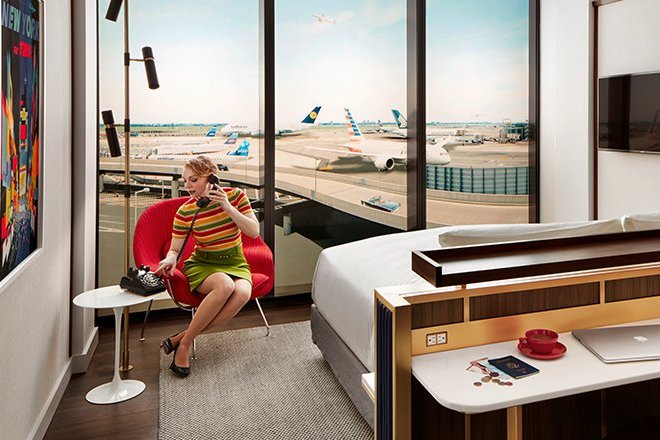
Spacious wicker airplane seats, a piano in the lounge, a swanky cocktail bar in the first-class cabin — remember the Golden Age of sophisticated air travel? Neither do we, because most of us weren’t even born yet, but it’s still fun to reminisce. This month, the TWA Hotel, a stunning reimagining of an icon of mid-20th-century air travel, announced that it’s now accepting reservations.
More than a half-century after its first opening, MCR Development (the brains behind NYC’s High Line Hotel) is wrapping up the relaunch of the vintage TWA terminal as the one-of-a-kind TWA Hotel. It will be the first and only full-service hotel at JFK International Airport accessible via the AirTrain. The $265-million project reinvigorates the terminal’s original Jet Age design, leaving much of it — the 200,000-square-foot lobby, Solari split-flap message board, sweeping entryway, and sunken, heart-shaped sitting area — intact.
Every detail from the common areas to the 512 guestrooms was meticulously redesigned to fit the 1960s aesthetic. All feature a vintage, Don Draper-worthy wet bar custom finished in walnut, mirrors, brushed brass, and crystallized glass. Authentic Knoll furnishings, including an armless leather Eero Saarinen Executive Chair and walnut and brass desk, dot every room. Additional accents like an old-school rotary phone, quilted leather-look headboard, brass wall sconces, and a Hollywood-inspired bathroom complete with bubble vanity lights round out the look. Seven-pane, 4.5-inch thick, floor-to-ceiling windows (the second thickest in the world) ensure runway noise is never a concern.
Common areas include six restaurants, eight bars, an Intelligentsia coffee shop, and 50,000 square feet of event, conference, and meeting space. Plus, there’s a beautiful, 10,000-square-foot observation deck with a pool and panoramic runway views, and a Jet Age museum showcasing exclusive Trans World Airlines and mid-century modern memorabilia. To solidify its “green” status, the developers also secured full LEED certification.
Ahead of the TWA Hotel’s opening, aviation and architecture lovers could preview a glimpse of the terminal’s history and rebirth at One World Trade Center. There, a TWA Lounge had been fully recreated, complete with original red carpet remnants from the terminal, TWA travel posters, Saarinen-designed furniture, and an Ann Sacks penny tile designed to Saarinen’s specs.
When the Eero Saarinen-designed Trans World Airlines Flight Center, or TWA terminal, opened at New York City’s then-named Idlewild Airport in 1962, it represented a sea change in airport design. It was progressive, revolutionary, and just plain beautiful. The streamlined, low-slung exterior was inspired by the grace of a bird in flight; the convex glass and steel at its edges recalled gusts of air gently pushing the outspread wings skyward. Inside, the check-in desks, waiting areas, and halls blended seamlessly into one another, thanks to a forward-thinking floor plan by architectural legends Charles Eames, Warren Platner, and Raymond Loewy.

Trans World Airlines closed its last cabin doors in 2001. The terminal shuttered soon after and has been abandoned since. However, it was never forgotten. New York City granted the terminal landmark status in 1994, but in 2005 — years after it had already closed — it was also listed on the National Register of Historic Places and the New York State Register of Historic Places.
With an expected grand re-opening in May 2019, the TWA Hotel is on track to open its doors as expected. Travelers can book their stay now at TWAHotel.com with nightly rates starting at $249.







